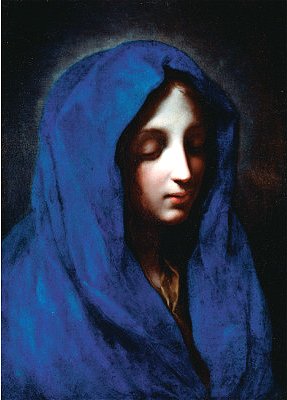THE BLUE MADONNA
Carlo Dolci, Italian, 1616-1687
SN 136, Oil on CanvasFrom "The Pages
ARTIST:
Carlo Dolci was born in Florence in 1616 and, as a child prodigy, trained there with
Jacopo Vignali beginning in 1625. He became the major Florentine painter of the 17th
century, spending almost his entire career in his native Florence.
He was renowned for his fine portraiture, and became a member of the Accademia del
Disegno. He began to paint a large number of works for private patrons; several paintings
commissioned by the Medici family now hang in the Palazzo Pitti. He also painted a number
of altarpieces. He enjoyed an international reputation in his own lifetime, his works
being highly prized by the British aristocracy.
He was a devout Catholic and considered his paintings an offering to God, even writing
prayers on the back of some of his works. His last years were spent in anxiety and sadness
due to his depression resulting from peer criticism. He died in 1686. |
|
 |
SUBJECT:
The Blue Madonna is beautiful in its simplicity. Light from above is falling on her face,
accentuating her innocence and peace….and just a hint of sadness. Her eyes are
downcast. A royal blue veil frames her head and is softly draped over her shoulders. A
shimmer of light just above her head gives the impression of a halo.
PAINTING:
The mix of sweetness and sadness is typical of Dolci. This painting could be hung in a
church as well as a home. A similar piece, Madonna and Child, hangs in the Royal apartment
Palazzo Pitti.
The religious context, the exquisite technique – imperceptible brushwork –
brilliant color are all Dolci characteristics.
HISTORIC CONTEXT:
The surface perfection of Dolci’s technique suggests possible influence of Bronzino
– and certainly that he had studied Flemish art. Florentine artists of the period,
unlike the Bolognese school, retained a significant interest in elegance and local detail,
apparent in rich dress and pose.
ringlingdocents.org
|